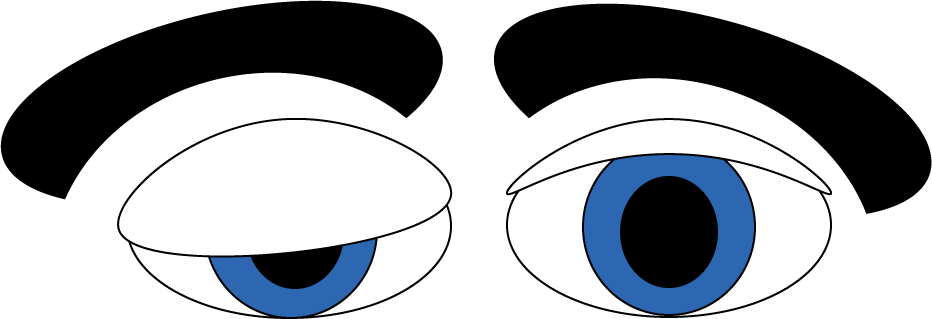Ptosis (Droopy Eyelid)
Ptosis (pronounced "toe-sis") is actually an abbreviation for the medical term blepharoptosis. Ptosis is a condition where one or both of the eyelids droop and obstruct vision. The cause may be anatomical, such as excessive skin (dermatochalasis) over the eyelids, traumatic, or neurological (damage to the third cranial nerve, myasthenia gravis, or Horner's syndrome for example). Neoplasms (growths) and scarring can also cause ptosis to develop.

In the image above, the right eyelid is the ptotic ("tot-ick") eyelid.
Eyelid Innervation
The eyelids rely on input from cranial nerve III (oculomotor nerve). The third cranial nerve affects the levator palpebrae superioris muscle. When stimulated, the eyelids open. A small amount of eyelid movement also comes from the sympathetic nervous system by means of the superior tarsal muscle, and also from the frontalis muscle controlled by cranial nerve VII (facial nerve).
Problems Caused by Ptosis
If the ptosis is complete or severe, vision may be obstructed. This rare case may lead to deprivation amblyopia - a more severe form of amblyopia that occurs when no light enters the eye.
More commonly, a patient is able to adopt a modified head position (often head back/chin-up) to help raise the ptotic eyelid.
Prolonged ptosis may cause a distortion to the eye's shape, leading to an asymmetric glasses prescription that changes over time.
Surgical Correction
Blepharoplasty
Blepharoplasty is the surgical term for an eyelid lift and is commonly performed when the ptosis is due to dermatochalasis. During surgery, excessive eyelid skin and fat (adipose tissue) are removed and the surgical wound is sutured shut. Although both upper and lower eyelids can be operated on, upper lid blepharoplasty is far more common than lower lid blepharoplasty.
Frontalis Sling
Here the musculature of the frontalis muscle is linked to the connective tissue of the upper eyelid termed the tarsal and epitarsal tissue. Once performed, eyelid elevation occurs by engaging the frontalis muscle of the forehead.
Levator Resection
Resection and advancement (anterior placement of the muscle) effectively shorten the levator palpebrae superioris muscle, allowing small movement of this muscle to be more effective in raising the eyelid.
Browpexy
Although not technically a direct ptosis surgery, browpexy may be performed along with upper eyelid blepharoplasty. Browpexy essentially attaches internal eyebrow fat to the tough connective tissue of the brow bone, called the periosteum. The end result is a tightened eyebrow and less droopy excess skin.
Non-surgical Options
Unfortunately, there are very few non-surgical options for ptosis correction. Ptosis crutch eyeglasses are sometimes helpful. Ptosis crutch eyeglasses us a small wire or plastic bar attached to the glasses frame that applies pressure to the eyelid to keep it mildly elevated.
